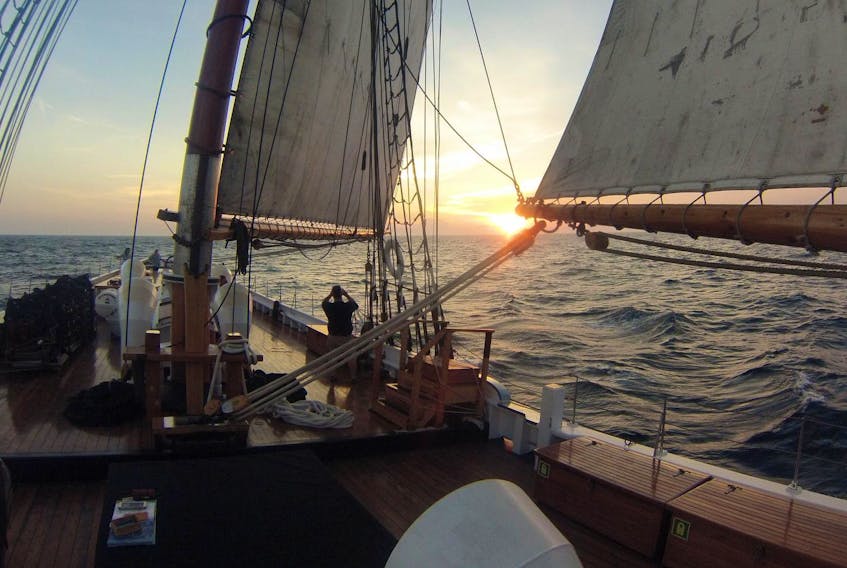When we first arrived to the Bluenose II, she was completely bare-bones and wrapped in her white plastic winter dress. We were going to be responsible for cleaning her up, rigging the lines and sails and polishing her once again to be that lustrous schooner you see on the Canadian dime, or in those majestic Nova Scotia tourism photos.
A small crowd of deckhands gathered in the rigging shed, meeting each other for the first time, having no idea what the season would bring. An unsettling feeling hovered over us, knowing that soon these strangers would become our family.
Blocks hung from the rafters, row upon row, ready to be sanded, varnished, sanded again and varnished again. Part of the meticulous maintenance was character building, the officers admitted. But most of it can be best summed up by an old seamanship concept called the black box theory.
On every vessel, there is an invisible box. Each time you do something seaman-like or good for the boat, such as recoil a messy line, touch up chipped paint, wear your clipped-in lifejacket in stormy weather or properly splice a rope instead of tying a simple knot, points go into the box. The points are spent at sea when the bow is fiercely crashing through waves, when weather turns and the sea gets angry, when something structural fails or accidents happen.
This idea was instilled in us from the beginning: if you look after your ship and your crewmates, they will in turn look after you. After a month and a half of arduous maintenance and rigging, it was safe to say the points in the box were plentiful.
We looked after her like she was our own. After each day sail or public deck tour, we would comb her luminous douglas fir decks for debris and polish out the footprints. We carefully whipped the ends of her lines so they wouldn’t fray. We wiped the salt off her varnished spars after long voyages. We repainted her hull, routinely oiled the decks and fixed each flaw as she sailed through the season.
We attentively scrubbed her decks and polished her brass every morning. We furled her sails properly and smoothly after setting them. Every Monday we donned our maintenance clothes and brought her back to ship-shape for yet another week.
We were proud of our ship and it was with honour we showed her off to the world during the Rendezvous 2017 Tall Ships regatta, displaying our heritage to awe-inspired visitors and fellow sailors in Boston, Mass., Quebec City, and many ports in between. We were proud to share her story with captivated tourists.
We looked after each other too. It wasn’t long before the 14 deckhands knew each other better than they’d ever thought (or wanted) to know each other.
We celebrated great victories together: our first sail during training week when the mainsail went up and we all, dwarfed by its sheer greatness, looked up at it in utter disbelief.
We bit the ropes vibrating by the force of the wind on the sails, laughing at how it felt on our teeth. We were both anxious and elated at the novelty of it.
Our first transit — Lunenburg to Boston — was more fantastical sailing than any of us could have asked for. Seeing the tall ships in the parades of sail from the crosstrees, 100 feet in the sky, made us feel like we were in a different era.
The first time we set all eight sails in Chester and tacked about all day, launching the small boat so we could all see her from afar in all her canvassed beauty, providing a whole other perspective.
We celebrated little victories: a birthday, a new job, the day we all got to dress as superheroes and unexpected days off from poor weather.
We laughed ourselves to tears during meals at the fo’c’sle table, we pondered life’s greatest questions together on watch with the open ocean as our backdrop, sometimes providing answers itself. We ate together, lived and worked together, argued together and supported each other, physically and mentally. We were a family of siblings.
Bluenose II taught us good seamanship, crafting a more traditional type of seafarer than perhaps any other program in Canada. It was incredible to see myself and my fellow deckhands grow from knowing almost nothing about boats to being well-versed sailors by the end of the season.
There were of course challenging times aboard Bluenose II. Rain, high winds and fog frequently reared their hazy heads. Answering the same tourist questions in the July sun for hours on end, standing an uneventful watch in the middle of the night, and sanding mahogany handrails to bare wood were testing to say the least, but still we look back on the experience with thrill and delight.
It was the beginning of October and we were on our last transit of the season, travelling from Halifax back to her home port of Lunenburg. I was on the 8 p.m.- 12 a.m. watch. I came up on deck, lifejacket on, to find a dark angry sea and ferocious wind.
Each of us passed around mints to try to suppress the seasickness as we tried to keep our balance while the bow plowed through each crest and trough. I took the helm, a comforting duty to take my mind off seasickness and also a great way to stabilize myself atop a rolling sea.
It sounds like a scary scene, but we were not afraid. We had grown to trust each other with our lives (literally, for it was fairly common for someone to be aloft on a bosun chair, being hoisted and eased on a line with their fellow crewmate on the other end). The black box was surely full of points now.
We brought her back to the wharf in Lunenburg where we all signed on six months earlier. It was time to put her to bed for yet another winter. We stripped off her winded sails, furling them carefully for the last time, requiring all hands to stow her 4,150-square-foot mainsail. We unreeved her weathered blocks and neatly coiled her lines, stowing them away in the rigging shed, solemnly waiting to say goodbye to her and to our newfound family.
We did our best to take care of her as she took care of us. She was back to the bare-bones vessel we started with — the only difference: we now knew every inch of her.
In the winter months, we reminisced over beer with former crewmates, each of us well-groomed for a career in seafaring and each of us excited to set out to sea again; some as professional sailors, some as recreational boaters. Whatever the path, the Bluenose II instilled a lifelong passion for sailing and the sea in all of us.
We think back on memories of the summer we spent on a Canadian icon, examining photos that bring back squalls of feeling, and we remember it like a dream.









